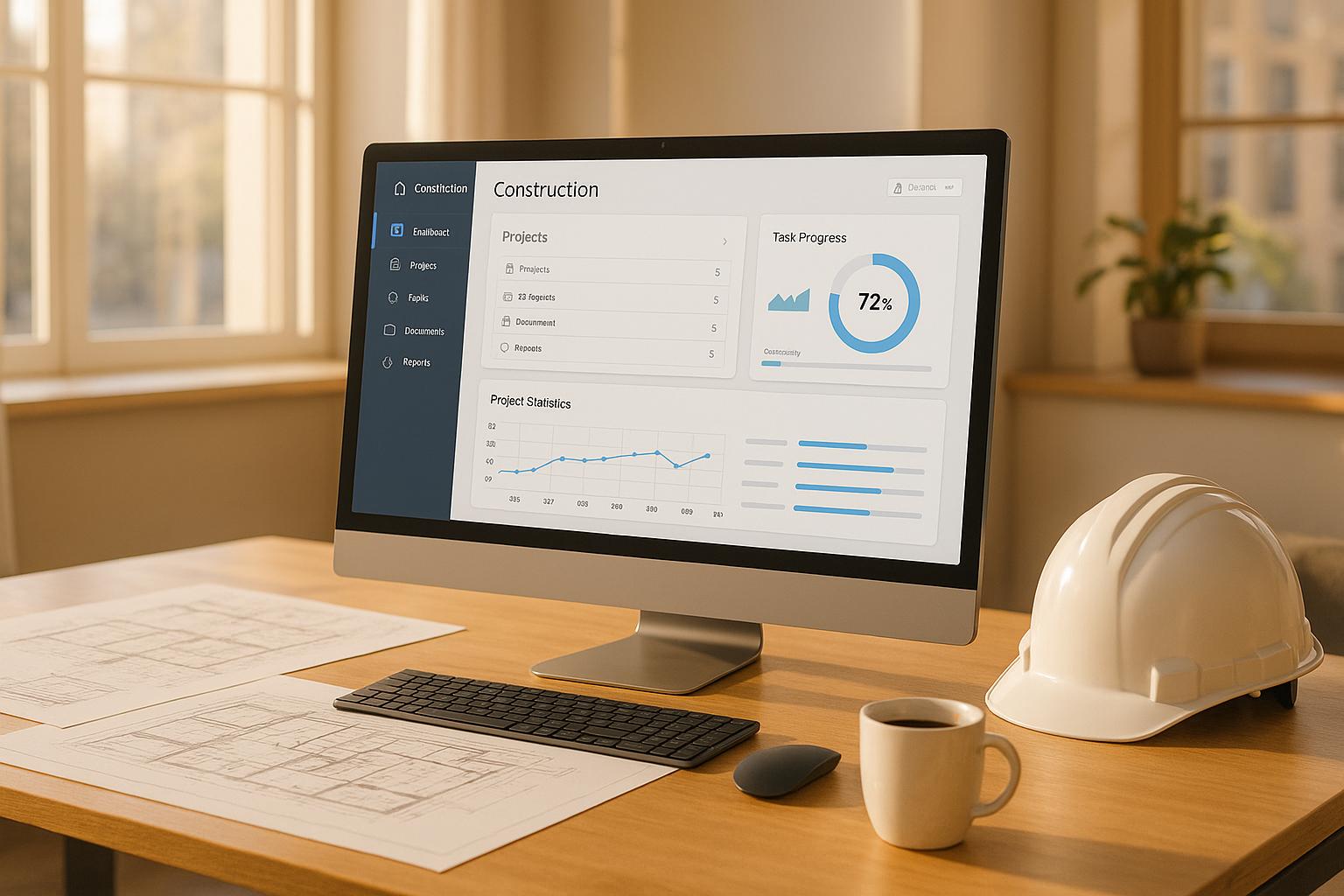The Real Cost of Developing Construction Software: Market Analysis 2025
Taher Pardawala August 16, 2025
Developing construction software in 2025 is more expensive than it seems. Beyond salaries and hosting fees, hidden costs like technical debt, scaling challenges, and compliance updates can inflate budgets over time. Here’s a quick breakdown of what drives costs:
- Feature Complexity: Advanced capabilities like IoT tracking, predictive analytics, and mobile offline access significantly increase expenses.
- Technology Choices: Using modern, well-supported tech (e.g., React, Node.js) can reduce costs, while outdated or niche tools may lead to higher long-term expenses.
- Team Structure: In-house teams offer control but cost more. Outsourcing or hybrid models can save money but come with risks like communication issues.
- Hidden Costs: Long-term expenses include scaling infrastructure, addressing technical debt, and maintaining compliance with evolving regulations.
To manage costs, phased development (starting with an MVP), automation, and careful planning are key. These strategies help avoid budget mistakes, such as underestimating mobile development or data migration challenges. Ultimately, planning for both upfront and long-term costs ensures a scalable and efficient solution.
Estimate Software Development Costs
Main Cost Factors in Construction Software Development
Breaking down the core cost factors helps shed light on the various expenses involved in creating construction software. These factors are the driving force behind the overall development costs.
Feature Complexity and Project Scope
The complexity of features and the overall scope of the project are among the biggest cost determinants. Basic features like project scheduling, document storage, and reporting form the foundation of most construction software. However, when you start incorporating advanced capabilities – like real-time IoT equipment tracking, predictive delay analytics, automated compliance reporting, or integration with specialized equipment – development time and costs rise significantly. Even seemingly simple features might need extra customization to accommodate specific measurement units, trade workflows, or seamless system integration.
Adding mobile functionality further complicates development. Construction teams often require offline access, which means creating sophisticated solutions for data synchronization and local storage.
Technology Stack Choices
The technology stack you choose has a direct impact on both initial and long-term costs. Your selection of programming languages, frameworks, databases, and tools shapes hiring needs, hosting expenses, and ongoing maintenance.
"If the development approach defines how your product is built, the technology stack defines what it’s built with. As such, your tech stack carries serious cost implications." – Zhenya Kruglova, Head of Talent Acquisition, Lemon.io [1]
Using well-supported technologies can help reduce costs over time. For instance, popular frameworks like React for front-end development and Node.js or Python for back-end systems come with large developer communities, extensive documentation, and a readily available talent pool. On the other hand, relying on legacy or niche technologies often demands specialized expertise, which can increase hiring and maintenance costs. Additionally, proprietary platforms may lead to vendor lock-in, potentially requiring costly migrations down the line.
| Technology Choice | Cost Impact | Long-term Considerations |
|---|---|---|
| Open-source frameworks | Lower licensing costs; faster development | Large talent pool; extensive community support |
| Proprietary platforms | Higher upfront licensing fees | Potential vendor lock-in; limited flexibility |
| Bleeding-edge technologies | More challenging hiring; slower delivery | Limited documentation; smaller talent pool |
| Legacy systems | Higher maintenance costs | Outdated security and scalability concerns |
These decisions also influence your team structure and operational infrastructure, which are critical cost components.
Development Teams and Infrastructure Costs
The makeup of your development team and the infrastructure you choose can significantly affect expenses. In-house teams provide full control over the project but come with substantial costs, including salaries, benefits, and operational resources. Outsourcing may lower upfront expenses but can introduce challenges like communication gaps, time zone differences, and inconsistent development standards. A hybrid model, such as engineering-as-a-service, offers a middle ground by providing specialized expertise without the long-term commitment of hiring full-time staff.
Infrastructure costs are another major factor. These include hosting, security, backups, compliance tools, and DevOps solutions. Additionally, integrating third-party tools for tasks like estimating, scheduling, accounting, and equipment management often requires ongoing development work and subscriptions for services such as document storage, real-time communication, analytics, and compliance monitoring. These costs often align with the hidden expenses discussed earlier.
Hidden Costs and Long-Term Expenses
It’s easy to focus on upfront development costs, but the real financial picture often emerges after launch. Hidden expenses can sneak up on you, significantly increasing your overall budget if they aren’t accounted for early on. Let’s break down some of the most common challenges and their lasting effects.
Technical Debt Accumulation
Technical debt arises when teams take shortcuts to meet deadlines instead of implementing more durable, long-term solutions. While these quick fixes might save time initially, they often lead to bigger problems down the road. For example, in construction software, early integration with external systems may seem sufficient at first. But if those systems evolve, additional work may be required to keep everything running smoothly. Over time, these early compromises can lead to higher costs for refactoring and optimization, all in the name of maintaining performance and security. Left unchecked, technical debt can snowball, making scaling and ongoing support even more expensive.
Scaling Infrastructure and Code
As your construction software grows – handling more users and larger projects – scaling becomes a critical (and costly) concern. A system that works fine with a small user base might buckle under the pressure of increased demand if scaling wasn’t part of the original plan. For example, as project data grows, database performance can degrade, requiring significant redesigns or optimizations. Cloud hosting costs, including storage, data transfer, and computing power, can also spike during peak usage times. Early architectural decisions, like choosing a monolithic design over a modular one, play a huge role in how easily (or painfully) your system can scale. These challenges often lead to higher maintenance costs over time.
Ongoing Support and Software Updates
Launching your software is only the beginning. Post-launch, you’ll need to invest in regular updates, bug fixes, and security patches to keep the system running smoothly. As your user base grows, so will the demand for customer support. On top of that, changes in industry regulations or compliance standards may require frequent updates to ensure your software stays up to date. Don’t forget about recurring costs from third-party services like security monitoring, backups, and analytics tools – they can quietly add up, becoming a steady drain on your budget over time.
sbb-itb-51b9a02
2025 Market Data and Budget Guidelines
When planning construction software development, understanding market trends and aligning budgets accordingly is essential. Market data offers a clearer picture of where to focus resources, helping to set realistic financial expectations.
Market Size and Growth Data
The U.S. construction software market is growing quickly, fueled by the increasing adoption of digital tools and stricter regulatory demands. Mid-sized construction firms, in particular, are ramping up their software investments, highlighting a strong demand for advanced solutions.
One major trend reshaping the market is the shift to Software-as-a-Service (SaaS) models. Instead of one-time licensing fees, SaaS relies on subscription-based pricing. This shift impacts development budgets, as SaaS platforms require ongoing infrastructure maintenance and operational costs, unlike traditional software.
Another key factor is the rise of mobile-first development. Field teams now rely heavily on mobile apps for project management, making mobile optimization a must. While prioritizing mobile functionality can increase development costs, it’s essential to meet industry expectations and remain competitive.
Expected Budget Ranges
Construction software development costs vary widely, depending on the scope and complexity of the project. Budgets can range from creating a Minimum Viable Product (MVP) with basic project management features to building fully integrated platforms with advanced capabilities like real-time collaboration, equipment tracking, automated reporting, and compliance tools.
For enterprise-level projects, costs rise significantly due to the need for tailored solutions, complex workflows, and strict regulatory compliance. Beyond development, operational expenses – such as updates, maintenance, and scaling – play a significant role in determining the overall investment.
Direct vs. Hidden Costs Comparison
Effective budget planning requires a clear understanding of both visible costs and less obvious hidden expenses. Some hidden costs to consider include:
- Development Teams: Staff turnover and training can add long-term expenses beyond initial salaries.
- Infrastructure: Scaling for user growth and ensuring robust security can lead to ongoing investments.
- Compliance: Adapting to new regulations often requires regular updates.
- Integration: Maintaining third-party connections demands continuous support.
- Quality Assurance: Ongoing testing and performance improvements contribute to lasting costs.
Over time, hidden costs can rival or even exceed initial development expenses. To ensure sustainable growth, budgeting must account for the total cost of ownership, including both upfront and long-term investments. A well-rounded financial plan is key to successful software development in the construction industry.
Budget Management and ROI Improvement Methods
Smart budget management transforms construction software projects into tools that deliver measurable value. By applying tested cost-control strategies, you can keep expenses in check while improving ROI. Building on earlier discussions about hidden and rising costs, these methods ensure a more predictable and efficient use of resources.
Phased Development for Cost Control
Breaking a project into smaller, manageable phases offers a practical way to manage risks and maintain financial control. Instead of launching a full-scale platform, start with a minimum viable product (MVP). This step-by-step method allows you to test the waters, understand market demand, gather feedback, and secure extra funding based on actual results – not assumptions.
A good example of this approach is the AlterSquare I.D.E.A.L. framework, which divides development into clear phases: discovery & strategy, design & validation, agile development, launch preparation, and post-launch support. Each phase has specific deliverables and well-defined budgets, helping to prevent scope creep and unexpected expenses.
Phased development also creates natural opportunities to reassess budgets. If market conditions shift or new regulations arise, you can adjust the scope and budget of future phases without disrupting the entire project. This adaptability is especially crucial in the construction sector, where regulations and market needs can change rapidly.
Using AI and Automation to Cut Costs
AI and automation are game-changers for reducing costs in construction software development. These tools can speed up workflows, improve code quality, and reduce the time needed to deliver features.
Take AlterSquare’s 90-day MVP program, for instance. It uses AI and generative tools to shorten development timelines and cut costs. Repetitive coding tasks, such as creating authentication systems or API endpoints, are automated, allowing developers to focus on more complex tasks like business logic and user experience.
Automated testing is another cost-saving strategy. Unlike manual testing, which can tie up QA resources for long periods, automated test suites run continuously, catching bugs early when they’re cheaper to fix. The upfront investment in automation often pays off during the first major update cycle.
AI-powered project management tools can also optimize resources. By analyzing past project data, these tools identify potential bottlenecks and suggest adjustments to avoid delays and extra costs like overtime.
Common Budget Mistakes to Avoid
Even with phased development and automation, budgeting errors can derail a project. Being aware of common mistakes can help you avoid unnecessary expenses.
One frequent error is underestimating the complexity of mobile development. Features like offline access, GPS tracking, and camera integration – often critical for construction software – require specialized expertise, which can drive up costs.
Data migration is another area where costs can spiral. Many construction companies rely on multiple software tools, and transferring historical project data, client records, and financial information demands careful planning and skilled execution.
Infrastructure planning is also vital. Software that works well in testing environments may falter during high-demand periods, such as when multiple job sites upload reports, photos, and updates all at once. Preparing for these spikes ahead of time is far more cost-effective than scrambling for emergency fixes later.
Successful projects often set aside part of their budget as a contingency fund. This buffer allows teams to handle unexpected challenges without jeopardizing the project’s timeline or overall goals.
Conclusion: Planning Development Costs for 2025
Developing construction software in 2025 demands more than just basic budgeting – it requires a thoughtful approach to every layer of expense. From upfront development costs to hidden technical debt and compliance needs, understanding the full financial picture is essential for creating software that is both scalable and profitable.
Smart projects account for hidden and future costs, allocating resources to tackle challenges like technical debt, scaling, and regulatory updates. This forward-thinking approach helps companies avoid unexpected financial hurdles that could derail progress, especially in a market that’s anything but predictable.
Breaking projects into phases is a proven way to manage costs and validate demand. By taking things step by step, companies can test their ideas in the market, secure additional funding based on real results, and adapt to shifting regulations – all without risking their entire investment. This method is especially useful in the ever-changing construction technology landscape, where compliance and market conditions can shift quickly.
Tools like AI and automation are game-changers, speeding up development and improving code quality. By automating repetitive tasks, these technologies free up developers to focus on refining complex features and improving the user experience.
Working with experienced partners is another key to success. Experts who understand the unique challenges of construction software – like offline functionality, GPS integration, and migrating data from older systems – can help businesses avoid common budgeting mistakes and deliver more efficient solutions.
Taking a long-term view is critical. Software that’s built to scale, stay compliant, and adapt to market changes will always outperform solutions designed with only short-term savings in mind. Investing in solid architecture, automated testing, and phased development pays off by creating software that grows with your business and delivers a strong return on investment.
As the construction technology industry evolves, the companies that succeed will be those that strike the right balance between immediate needs and long-term strategy. By planning with both the present and future in mind, businesses can develop software that’s robust, scalable, and ready to meet the demands of a changing market.
FAQs
How can construction software developers manage hidden costs and technical debt effectively over time?
To tackle hidden costs and technical debt effectively, construction software developers should focus on a few key practices. Start with regular code refactoring to keep the codebase clean and efficient. Combine this with clear, up-to-date documentation to ensure everyone stays on the same page. And don’t overlook the importance of automated testing tools – these can catch potential issues early before they spiral into bigger problems. Together, these steps can help prevent costly setbacks and keep long-term expenses in check.
On top of that, encouraging cross-team collaboration can break down silos and improve communication. Pair this with AI-driven monitoring tools for a deeper understanding of system performance and technical debt. Proactively addressing these areas not only supports scalable development but also helps maximize your return on investment (ROI).
How does choosing the right technology stack affect the cost and scalability of construction software?
Choosing the right technology stack is essential for managing the long-term costs and scalability of construction software. The right stack can make development more efficient, reduce maintenance headaches, and ensure your software can grow smoothly as your needs evolve. It also helps protect against issues like security vulnerabilities and avoids the need for expensive overhauls down the road.
On the flip side, a poorly thought-out stack can lead to problems like technical debt, scalability bottlenecks, and higher costs – whether from licensing fees or increased resource demands. To set yourself up for success, it’s crucial to assess how well your stack aligns with your goals, budget, and the specific needs of your industry, all while keeping an eye on future growth.
What are the advantages of phased development, and how can it help control the budget for construction software projects?
Phased development brings clear advantages when it comes to managing budgets in construction software projects. By dividing the project into smaller, more manageable stages, expenses can be spread out over time. This helps improve cash flow management, easing the financial burden and making it easier to balance costs.
Another benefit is the flexibility it offers. Adjustments can be made between phases, which lowers the chance of expensive mistakes or budget overruns. On top of that, phased development strengthens resource planning by allowing for more precise cost estimates and better allocation of labor, tools, and materials. This approach helps keep your project on schedule and within budget, all while maintaining quality.








Leave a Reply